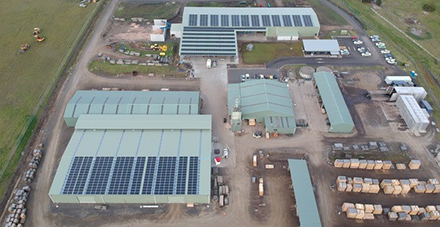Porta, a Victorian-based timber operation, recently upgraded its Bridgewater site in Tasmania with the installation of a sawmill alongside the existing drying, conditioning and finishing operations. This change now allows the site to receive green hardwood logs directly – a component of the supply chain which was previously outsourced. Source: Timberbiz
This project involved the construction of nearly 4,000 m2 of new buildings, which created the opportunity for the installation of a large rooftop solar power system. Porta saw an opening to offset the additional electricity demand through renewable energy and engaged Tasmanian-owned EB Solar to design a system to maximise on-site generation using the substantial roof area available.
Working together, the existing site loads were assessed from interval data and modelling of the additional loads from the new equipment to optimise the system size. Through discussions with TasNetworks it was confirmed that a 320kW solar power system could be installed, consisting of over 1000 solar panels.
EB Solar Managing Director, Sam Dingemanse said the business worked closely with the shed manufacturer on the design of the solar system and discovered Porta was also able to optimise the roof panel layout to maintain the use of skylights to reduce lighting loads.
“The site now boasts one of Tasmania’s largest roof top solar systems and is a credit to the commitment of Porta to invest in renewable energy to reduce its costs and their associated carbon footprint,” Mr Dingemanse said.
“There are many opportunities for renewable energy within the forest products industry, not only at major plants, but also corporate offices and other large electrical loads.”
To maximise the success of your solar project, EB Solar recommends:
- Making sure the system design considers your current and future electricity load to optimise the system size and prevent too much energy feeding back to the grid at a low tariff rate.
- Ensuring the solar provider can provide detailed financial modelling demonstrating the capital costs and expected energy savings over a range of scenarios, as well as the resulting investment returns.
- Speaking to your solar provider about Government assistance (such as grants, rebates and tax incentives) which may be available to you.








